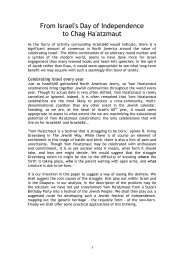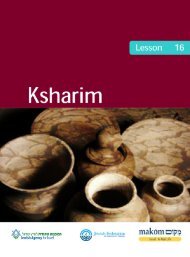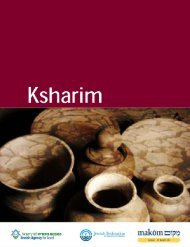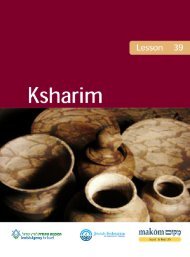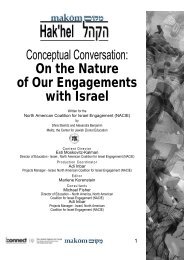Lihiyot Am Chofshi b'Artzenu To be a Free People in ... - Makom Israel
Lihiyot Am Chofshi b'Artzenu To be a Free People in ... - Makom Israel
Lihiyot Am Chofshi b'Artzenu To be a Free People in ... - Makom Israel
Create successful ePaper yourself
Turn your PDF publications into a flip-book with our unique Google optimized e-Paper software.
19 חג העצמאות – Ha'atzmaut Chag<br />
C. What experience to designate Look<strong>in</strong>g to the narrative<br />
What is the story of Chag Ha'atzmaut This is an important question to consider<br />
<strong>be</strong>cause the story we tell of an event, and the way <strong>in</strong> which we structure it, offers us<br />
many clues as to how to designate the experience of the chag and set the right mood.<br />
One of the most essential aspects <strong>in</strong> approach<strong>in</strong>g a story is <strong>in</strong> choos<strong>in</strong>g when the story<br />
<strong>be</strong>g<strong>in</strong>s, and when it ends. This is a value-laden, educationally-weighted decision. Does<br />
the story of Pesach end with the Hebrews successfully flee<strong>in</strong>g Egypt Or does it end with<br />
the receipt of the <strong>To</strong>rah at Mount S<strong>in</strong>ai Is this about freedom from, or freedom to We<br />
can see that the makers of the movie, Pr<strong>in</strong>ce of Egypt struggled unsuccessfully with this<br />
question. On the one hand, they knew that the dramatic climax to their story was at the<br />
cross<strong>in</strong>g of the Red Sea. The Hebrews were f<strong>in</strong>ally free from slavery, free from terror.<br />
But clearly some of the scriptwriters were not satisfied. And so a strange epilogue scene<br />
is tacked on to the end of the film, where Moses gazes on Mount S<strong>in</strong>ai. By alter<strong>in</strong>g where<br />
the story ends, The Exodus <strong>be</strong>comes, <strong>in</strong> this scene, about a journey from slavery to<br />
div<strong>in</strong>e covenant, not just a tale of escape. (Here we can appreciate the way <strong>in</strong> which<br />
Pesach – Exodus - and Shavuot - Mt S<strong>in</strong>ai - are so firmly l<strong>in</strong>ked through the count<strong>in</strong>g of<br />
the Omer)<br />
Joseph and his Technicolored Dreamcoat is a wonderfully successful tell<strong>in</strong>g of the<br />
Joseph story. But does the story of Joseph really <strong>be</strong>g<strong>in</strong> with his birth Can we fully<br />
understand the story without know<strong>in</strong>g how Joseph is the son of <strong>be</strong>loved Rachel, while<br />
the other brothers are born from other wives, less desired What about the simmer<strong>in</strong>g<br />
tensions that precede his birth, when Jacob condemns Shimon and Levi's massacre of the<br />
town of Shechem<br />
And so to our appreciation of Chag Ha'atzmaut. Where does our story of <strong>be</strong>com<strong>in</strong>g a<br />
free people <strong>in</strong> our own land, <strong>be</strong>g<strong>in</strong><br />
Does the story <strong>be</strong>g<strong>in</strong> with the Exodus – when as a people we first set off for the Promised<br />
Land Or does it <strong>be</strong>g<strong>in</strong> with the destruction of the Second Temple – when we lost our<br />
freedom and many were banished from our homeland Or with the Holocaust – the<br />
catastrophe that preceded a miraculous rebirth that Yitz Green<strong>be</strong>rg names a 'new<br />
Exodus' Or as Dov Marmur half-suggests, does the story <strong>be</strong>g<strong>in</strong> <strong>in</strong> 1948



